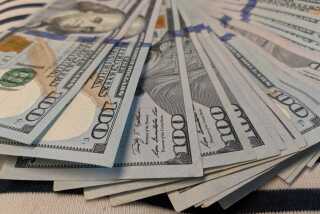Dollar Gains on Euro as U.S. Economy Picks Up
- Share via
Europe is getting cheaper for American tourists -- and more expensive for American exporting companies.
The euro currency slid Tuesday to its weakest level since mid-April amid more evidence that the U.S. economy is performing far better than Europe’s.
Though many factors can drive currency values, stronger economies generally have stronger currencies because they attract more investment capital than weaker economies.
The euro tumbled to $1.083 in New York on Tuesday from $1.098 on Friday. U.S. financial markets were closed Monday for the Labor Day holiday.
The euro peaked at $1.19 in late May as many currency traders remained skeptical about the dollar’s outlook, fearing that the U.S. economy might fail to gain traction.
But data in recent months have indicated that U.S. business activity is accelerating. On Tuesday, the Institute for Supply Management’s factory index showed manufacturing expanded in August at the fastest pace in eight months.
By contrast, an industry report Monday said European manufacturing activity declined in August, though the pace of contraction slowed. Germany, Italy and the Netherlands still are in recession, economists say.
“There’s a perception the U.S. economy is growing faster than Europe, and the capital flows reflect that perception,” said Michael Malpede, senior currency analyst in Chicago at Refco Group Ltd., the biggest U.S. non-bank futures brokerage.
Americans heading for Europe this fall will find that their dollars buy more as the euro sinks in value.
But the flip side is that the dollar’s new strength makes U.S. exports more expensive for European consumers.
The dollar isn’t rising against all other major currencies. Indeed, the Japanese yen has been rallying sharply in recent weeks. It closed Tuesday at 116.29 per dollar in New York. One dollar bought 120 yen as recently as Aug. 1.
The yen was the best performer of the major currencies in August, spurred by more signs that Japan’s long-suffering economy is picking up steam.
Industrial production in Japan rose 0.5% in August, more than twice the pace forecast by economists.
But a stronger yen is the last thing Japan wants now because it could raise prices of Japanese exports.
The Bank of Japan sold a record 9.03 trillion yen ($77.4 billion) in currency markets from January through August in an attempt to keep the currency’s value from rising.
“It is quite possible that the markets are testing the resolve of the Bank of Japan,” said Paresh Upadhyaya, who helps manage about $70 billion in international investments at Putnam Investments in Boston. “The markets have set their eyes on the next key level, which is probably 115.50” yen per dollar.
More to Read
Inside the business of entertainment
The Wide Shot brings you news, analysis and insights on everything from streaming wars to production — and what it all means for the future.
You may occasionally receive promotional content from the Los Angeles Times.










